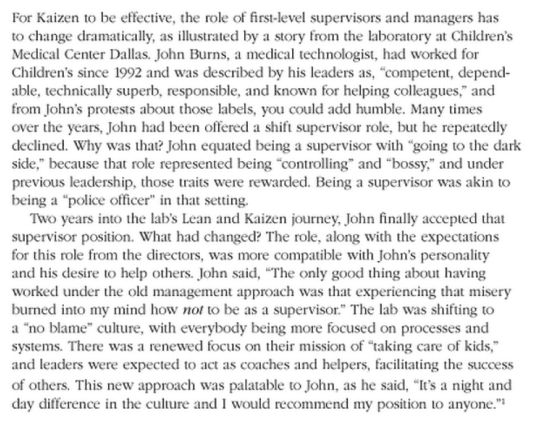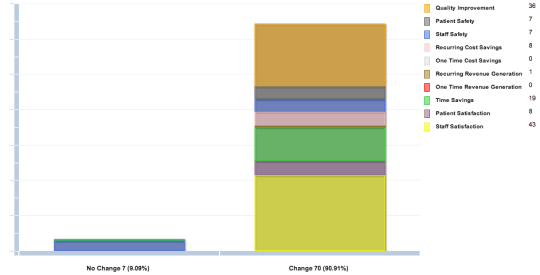I am giving a new webinar on Wednesday, hosted by the ThedaCare Center for Healthcare Value (to promote a public registration workshop on Kaizen that we're doing in October).
The webinar's theme is:
“Practical Continuous Improvement Leadership: Coaching, Not Judging”
I'll give a bit of a preview of the webinar in this blog post.
As I wrote about in Healthcare Kaizen, one of my favorite Lean transformation stories is the realization of an experienced medical technologist, John, that Lean leadership was about being “a coach, not a cop.” He had repeatedly said “no” to opportunities to become a supervisor, because that meant being “a cop” and policing people. He realized that Lean leadership was about being a supportive coach… so he said “yes” and became a successful manager.
Suggestion Boxes Fail, In Part, Due to Judging Behavior
One reason suggestion box systems fail (see more posts), is that employees are encouraged to put suggestions into a box. Once a month, or maybe once a quarter, a group reviews those suggestions and plays “judge.” This committee or a group of senior leaders judges each suggestion – usually without having the courtesy to talk to the person who suggested it!
They not only play “judge,” but they also play “executioner” and reject most suggestions. Suggestion box systems (paper or electronic) are notorious for rejecting 97 to 99% of suggestions for various reasons. This is what happened in the federal government. It's happened in many hospitals and many factories. No wonder employees choose not to participate! No wonder these suggestion boxes gather dust and die.
To create a culture of continuous improvement, leaders need to put away their gowns, gavels, and powdered wigs. They need to get paste their white coats and/or their ties and stop playing judge. John Toussaint, MD would say they need to stop being “control freaks.”
They need to start being coaches.

OK, that coach might be a bit “huggy” for those of you in manufacturing :-)
But think about what a coach does – a coach challenges you to do your best, helps you be successful, gives support and recognition.
That's exactly what we have to do in Kaizen.
Leaders need to get over their sense of power and the ability (or need) to “be right” in judging ideas.
How Leaders Can Coach
Be collaborative. Help people identify problems (not just throw out solutions). Help people find root causes, when necessary (or challenge them to do so). Brainstorm ideas with them (without domineering the conversation). Let people choose what they are going to test in a PDSA cycle.
If an employee comes to you with a “bad idea,” don't pass judgment. Be a coach. Ask them what the underlying problem is. Is it a real problem that should be addressed? It's your role, as a leader, to not kill the process by rejecting the idea. It's your obligation and responsibility to help your employes improve and success.
Ask questions – what else could we do to solve that problem? Is there a less expensive alternative that might have some positive effect?
If an employee has an idea that makes you think, “Well, that's not what I would do,” you don't get to say that. Well, not if you're trying to create a Kaizen culture. If you say things like that, people will disengage.
Let's say your employee (or your team) has an idea and you also have an idea. Which idea is best? You don't know until you TEST the idea. You're better off letting the employee test THEIR idea to see if it's effective or not.
As a leader, you DO have an obligation to step in if a Kaizen idea is somehow unsafe. But, instead of just saying “no” to the idea, you have to coach. Explain to the employees why it's unsafe (or ask questions that allow them to discover this). Does the idea violate a policy or regulation or law? Explain that to the employee. A coach helps their employees learn… and come up with other ideas. Or, the coach becomes a servant leader and works to change the unnecessary or unjust or outdated policy that's getting in the way.
In a nutshell — try to build a habit of not passing judgment on ideas. Instead, be a coach who helps people find things to implement.
That's how Kaizen systems lead to 90% implementation rates – whether that's Toyota or in a hospital department. Managers are acting as coaches to help people find SOMETHING to implement 90% of the time, even if it wasn't the original idea.
Here's data from one of our KaiNexus customers who are still pretty early into this Kaizen journey (click for a bigger view).
This hospital has implemented almost exactly 90% of their “Opportunities for Improvement.” It's only 77 so far, but that's a good start in their pilot areas. This implementation rate requires coaches, not judges. It requires the right sort of culture and the right sort of leadership. We can't change the culture overnight, but we can make big strides right away and then continue to get better.
What are you doing to be a better coach? To stop being a judge?
Please scroll down (or click) to post a comment. Connect with me on LinkedIn.
Let’s work together to build a culture of continuous improvement and psychological safety. If you're a leader looking to create lasting change—not just projects—I help organizations:
- Engage people at all levels in sustainable improvement
- Shift from fear of mistakes to learning from them
- Apply Lean thinking in practical, people-centered ways
Interested in coaching or a keynote talk? Let’s start a conversation.







![When Was the Last Time a Leader Around You Admitted They Were Wrong? [Poll]](https://www.leanblog.org/wp-content/uploads/2025/07/Lean-Blog-Post-Cover-Image-2025-07-01T212509.843-238x178.jpg)




One of the hardest things to do as a leader is to step back and not try to fix everything or make all the decisions yourself. Lean leadership takes quite a bit of humility and personal emotional intelligence.
But one of the most rewarding things is to see someone you’ve coached come up with a solution that you didn’t even think of and be successful with it. As a bonus, since it’s their idea they’re more invested in it working which means better sustainability!
Well said, Carrie!
Great read!
Many times leaders are put in their position BECAUSE they have lots of great ideas to improve their area/department.
How do you balance that with coaching the frontline to improve their ideas from bottom-up?
Thanks, Christina.
Part of the balance is to say that managers and leaders should participate in the process. They can ask questions. They can have input.
That said, there are risks to managers giving answers or solutions to employees:
1) It can reinforce old habits of relying on managers for answers, causing staff to step back and not participate as much
2) The managers might not have a current perspective on how the work is really done. I’ve seen this a lot in healthcare, where a nursing manager has troubling relating to how the work is currently done because they were never a floor nurse with EMR, they only did paper charts.
Managers can certainly come up with ideas to improve their own work as managers (or director or VP or whatever).
Managers can participate by coaching and facilitating. They should still be involved.